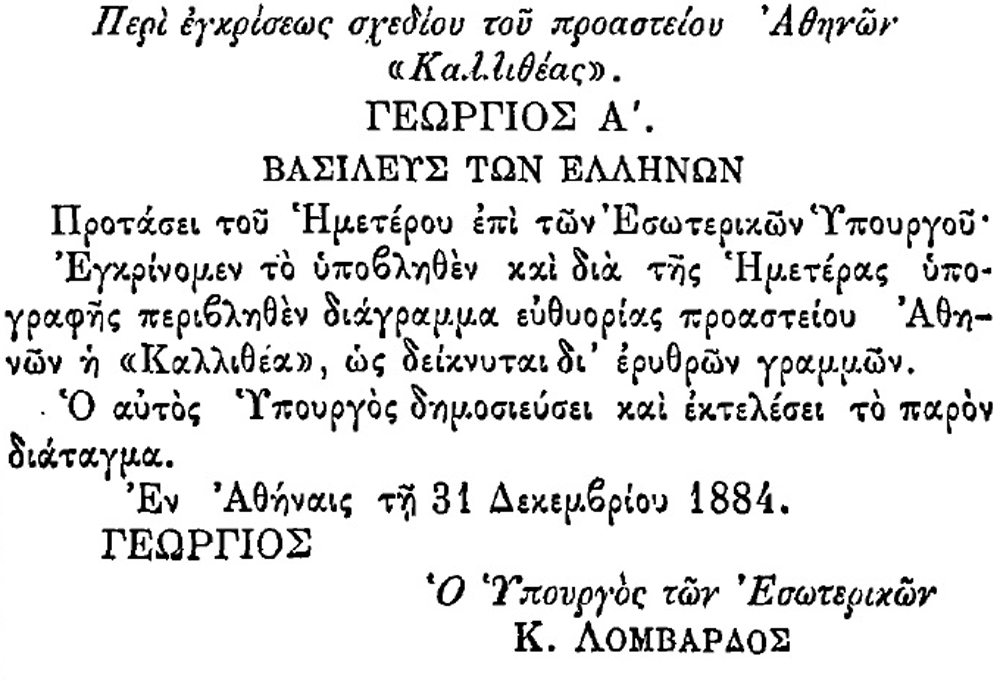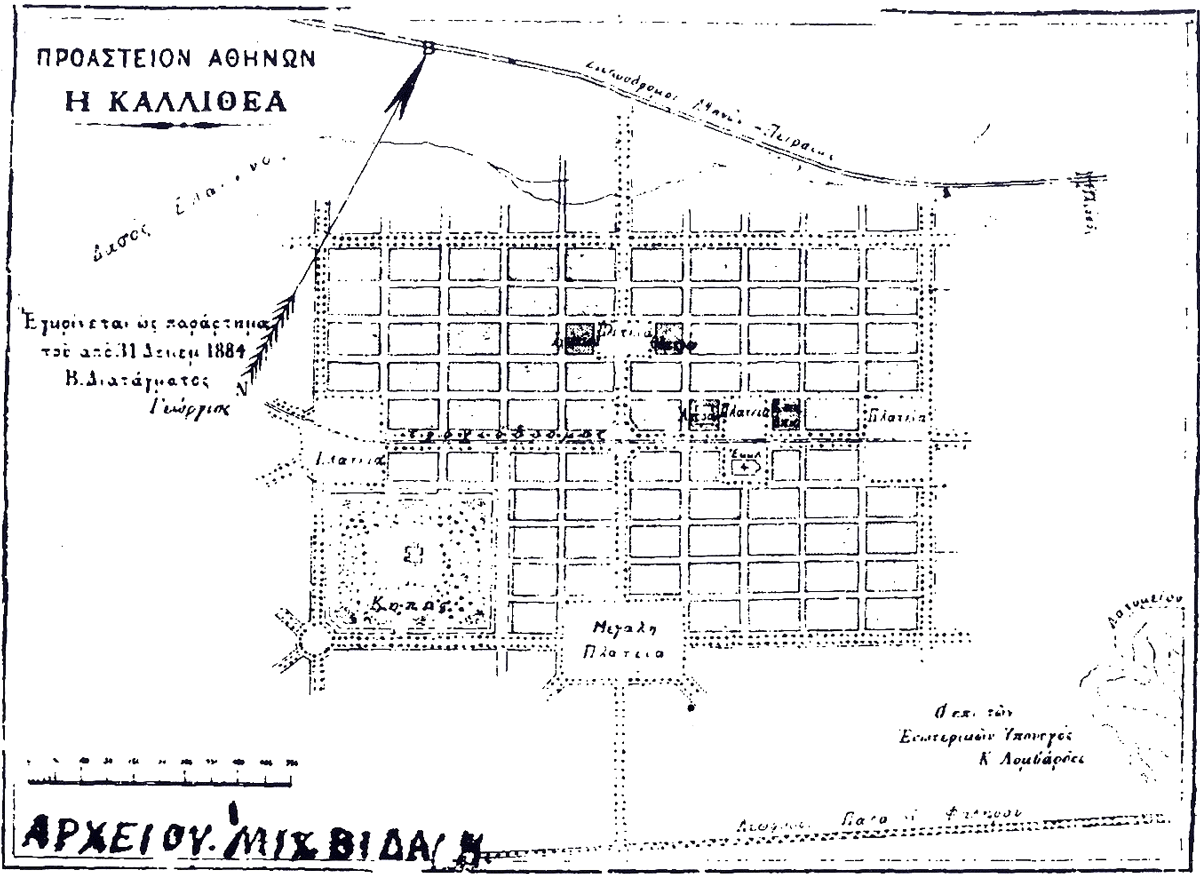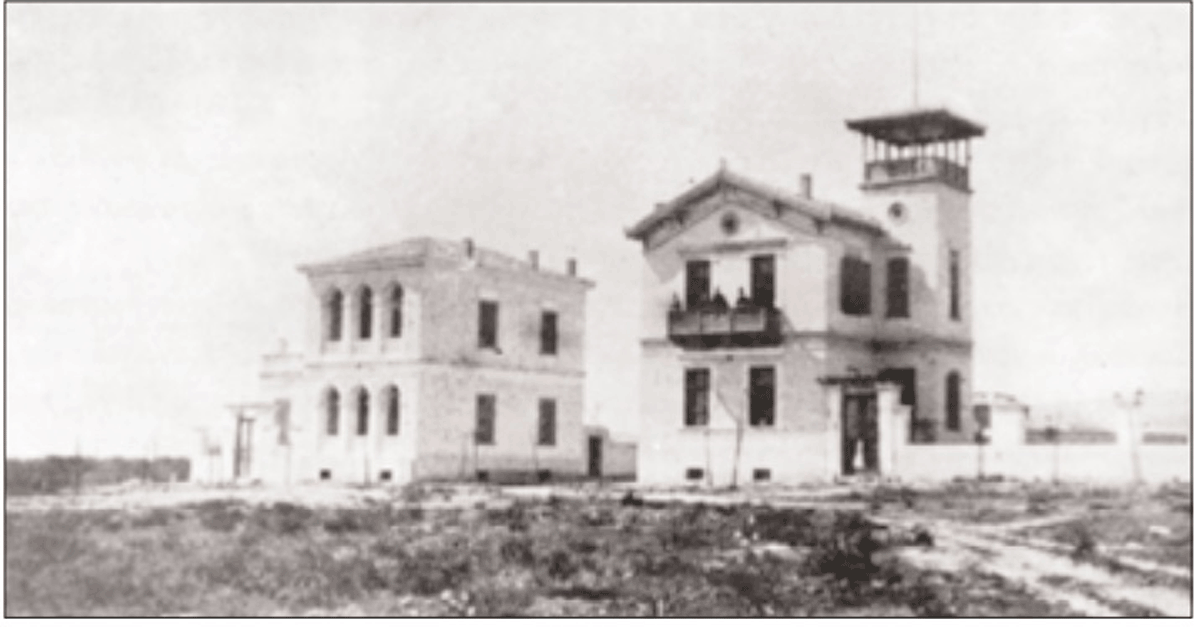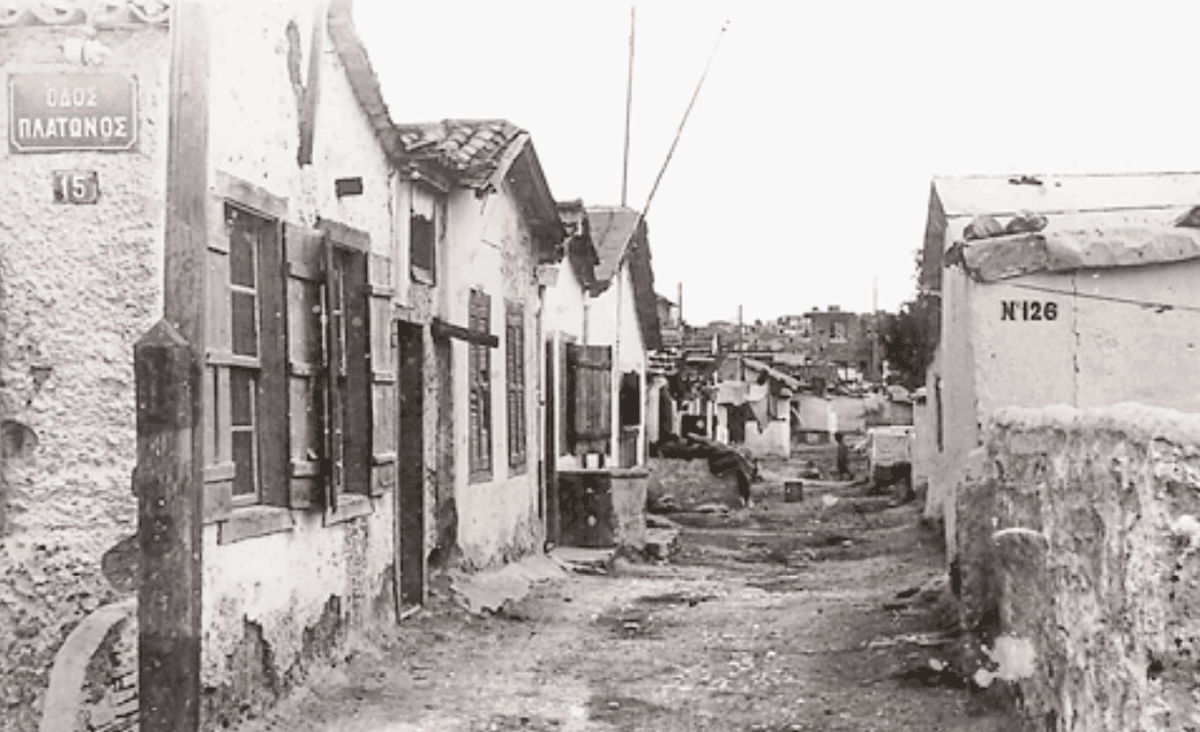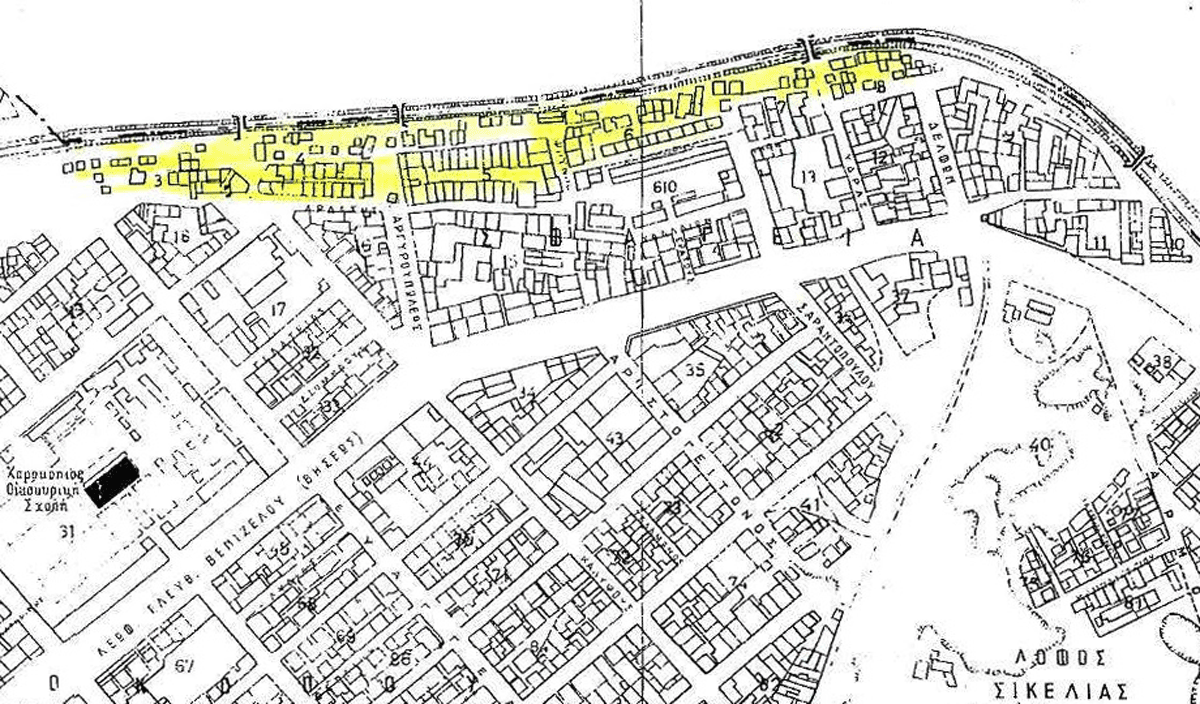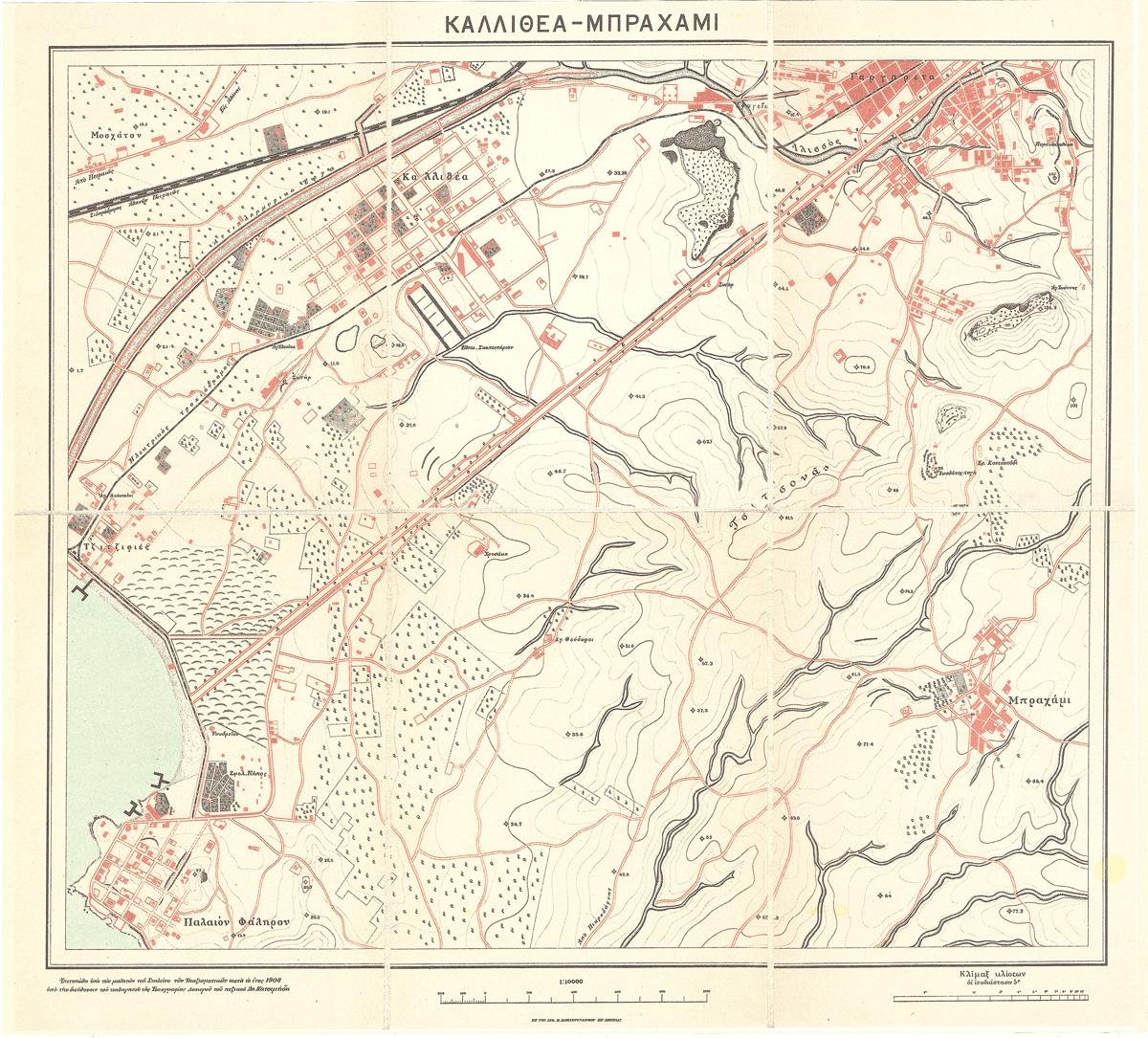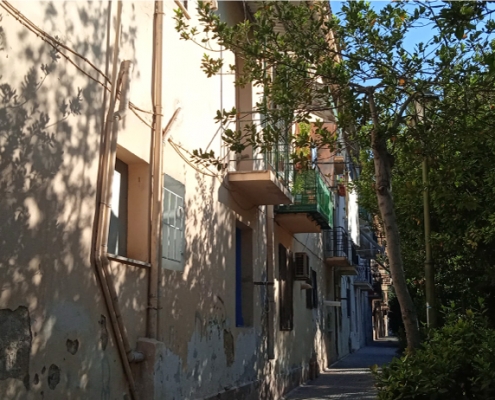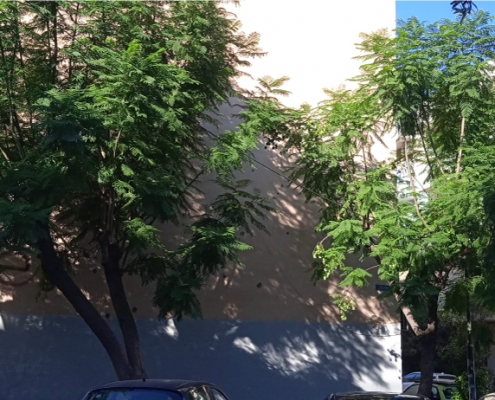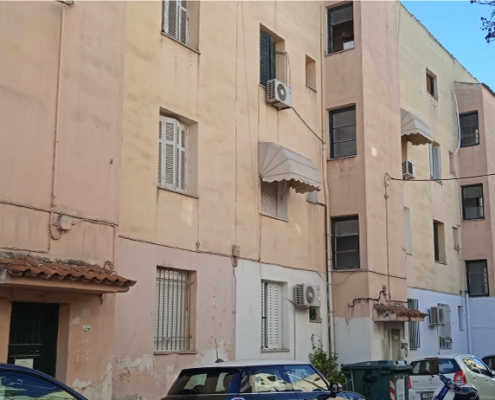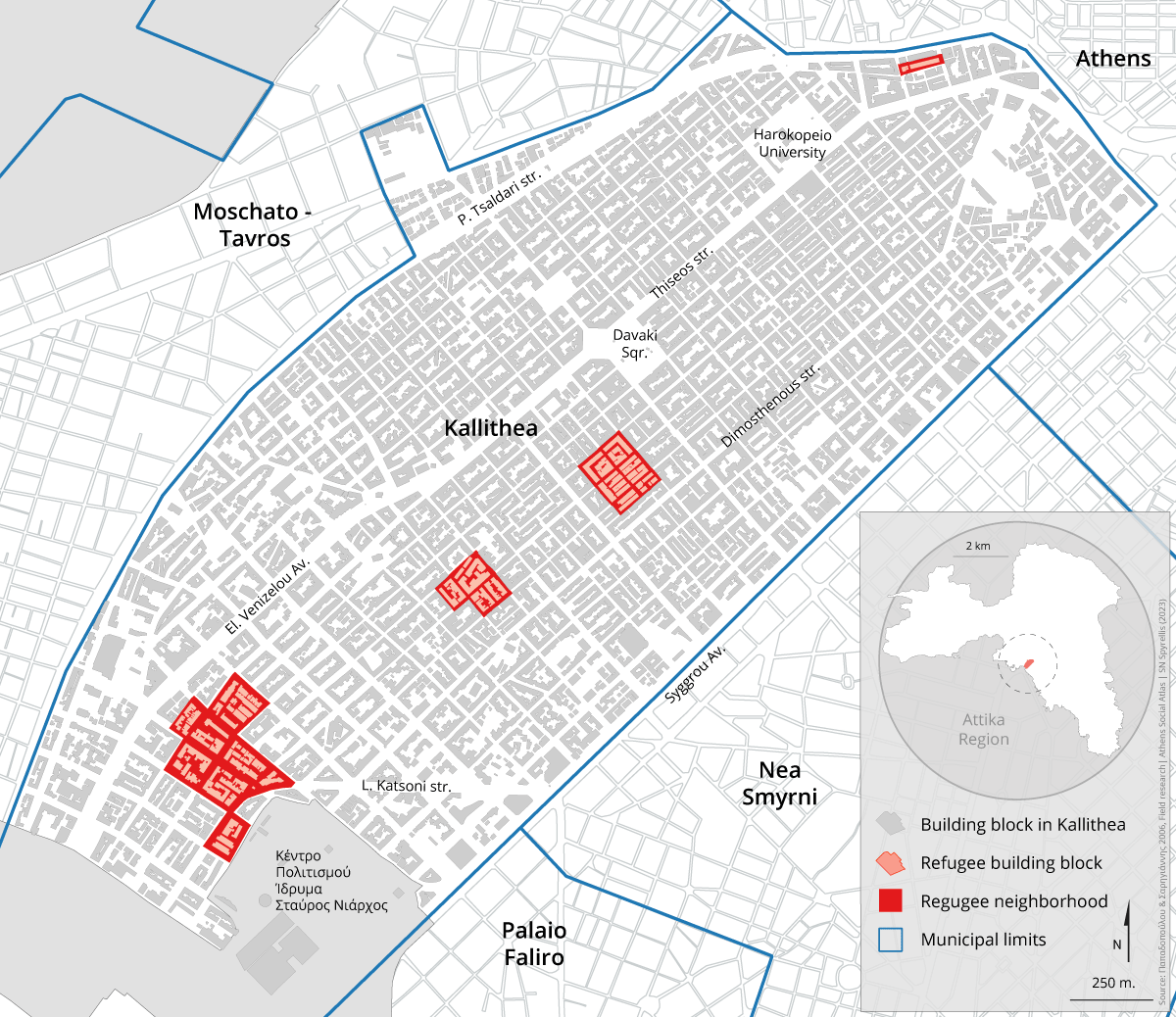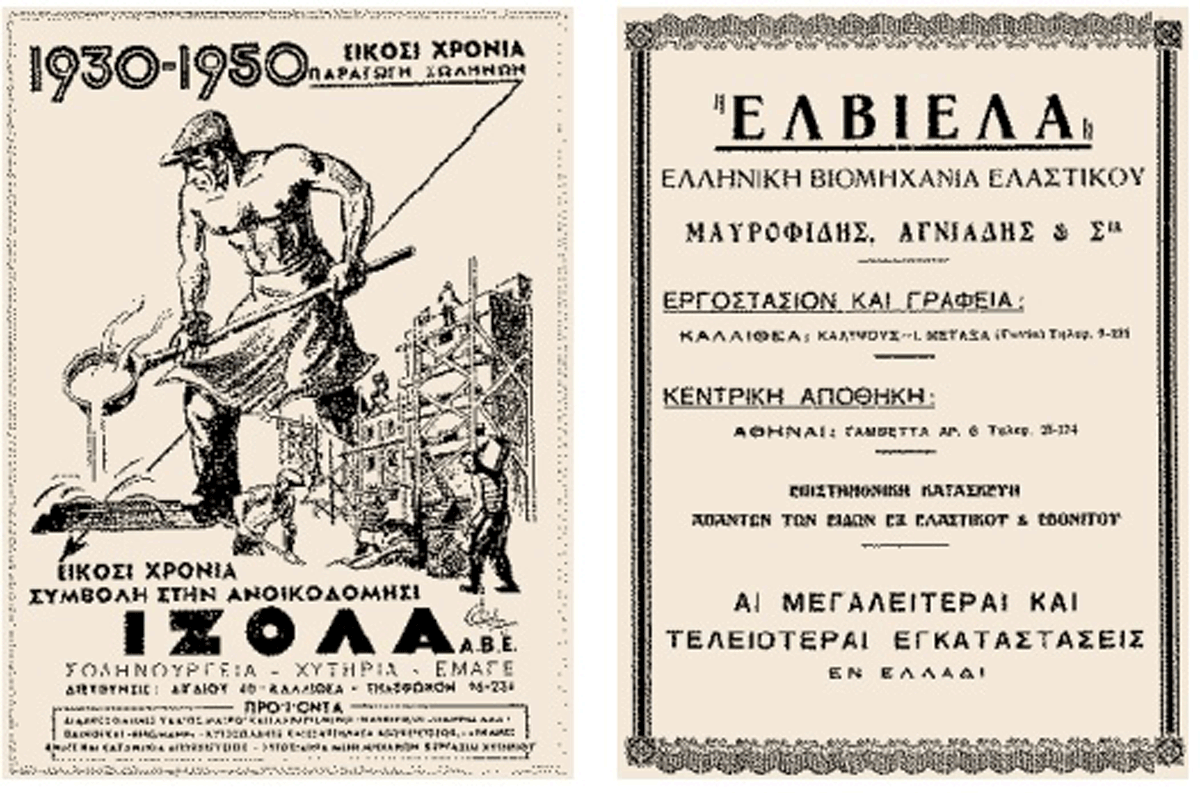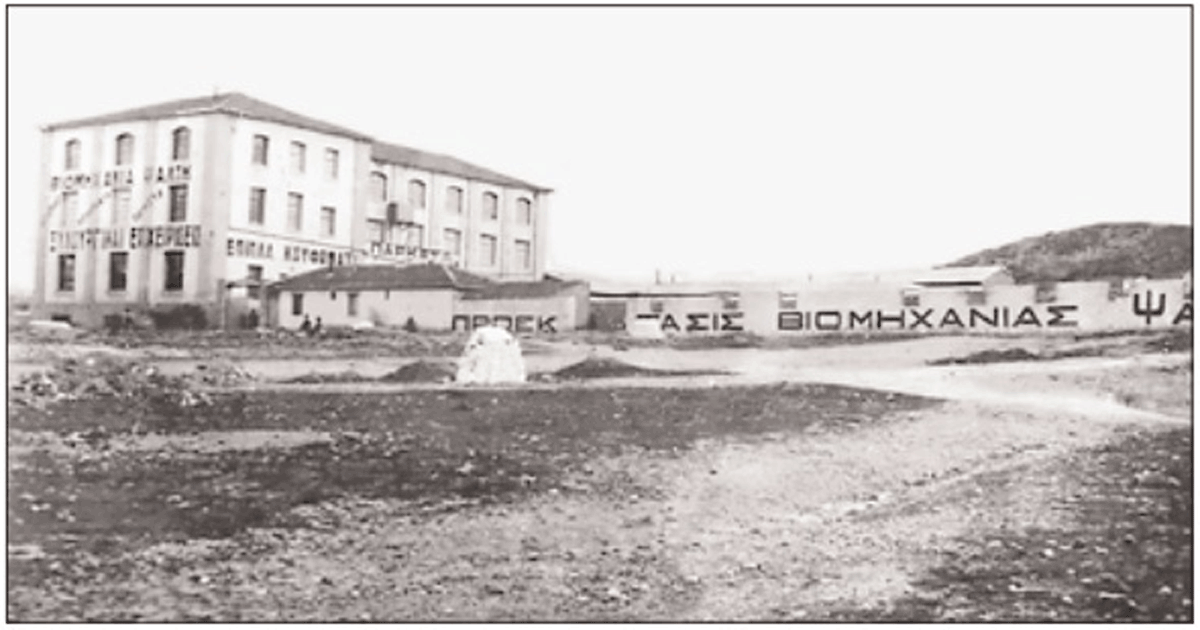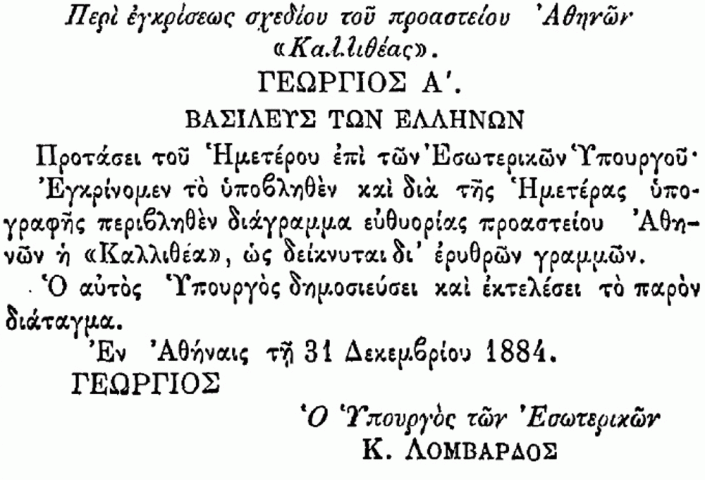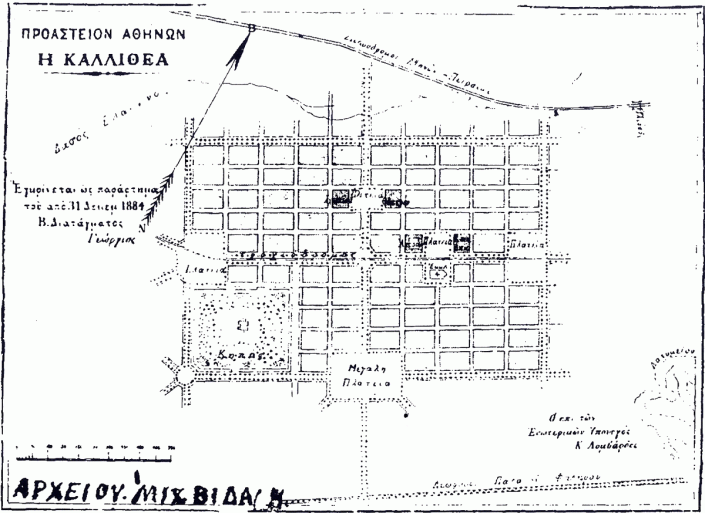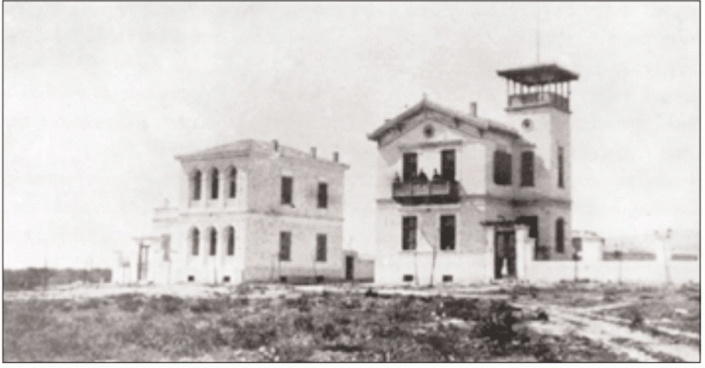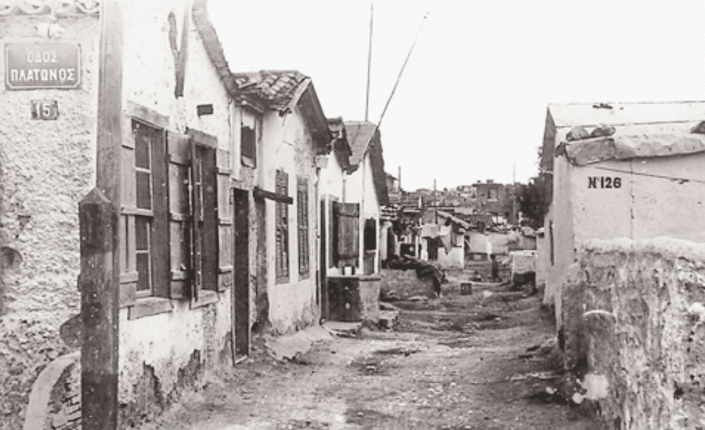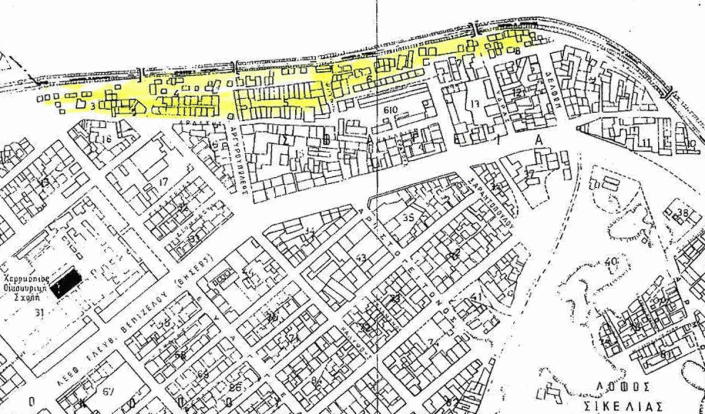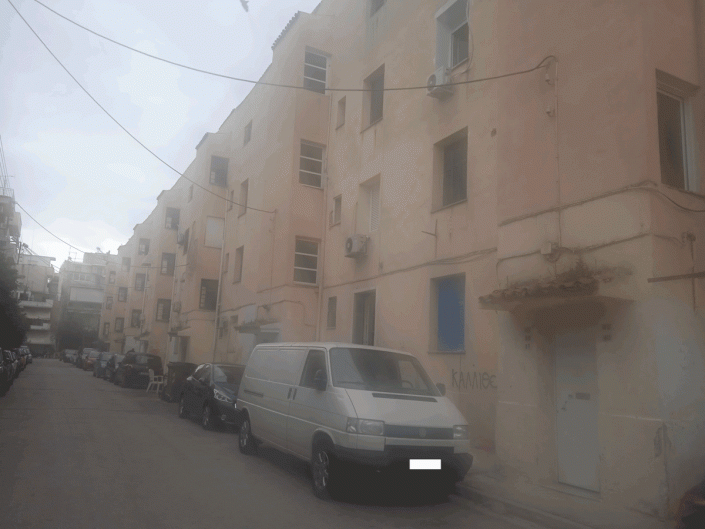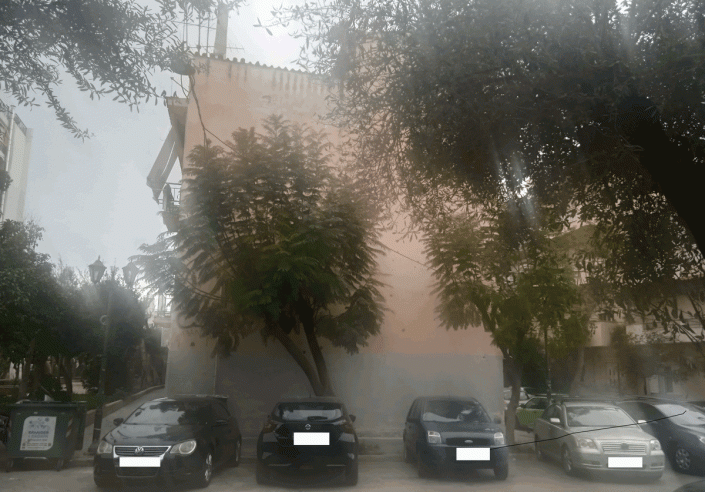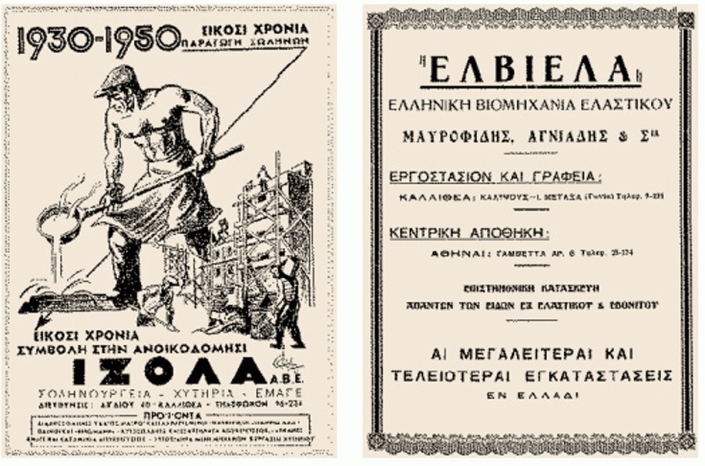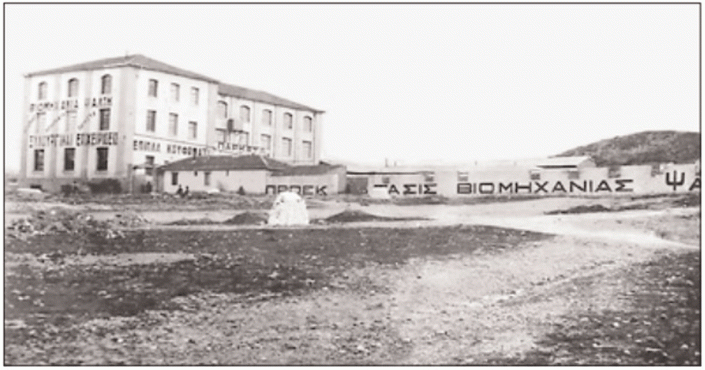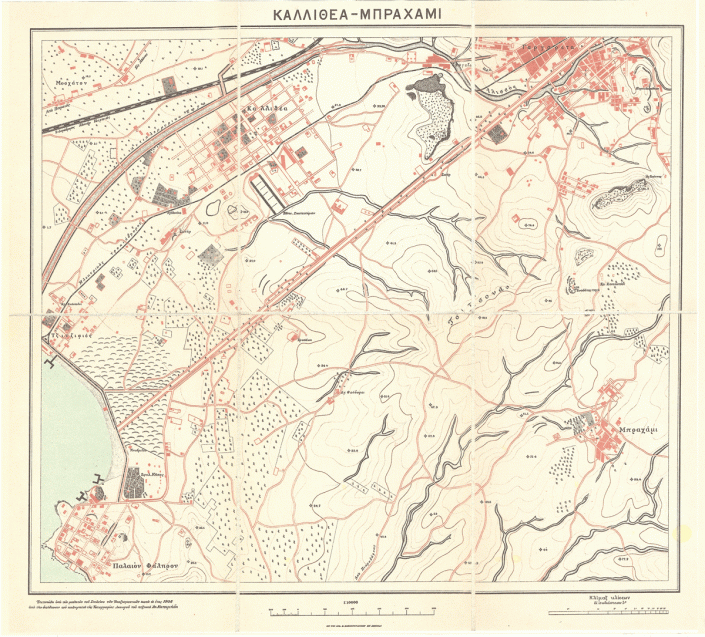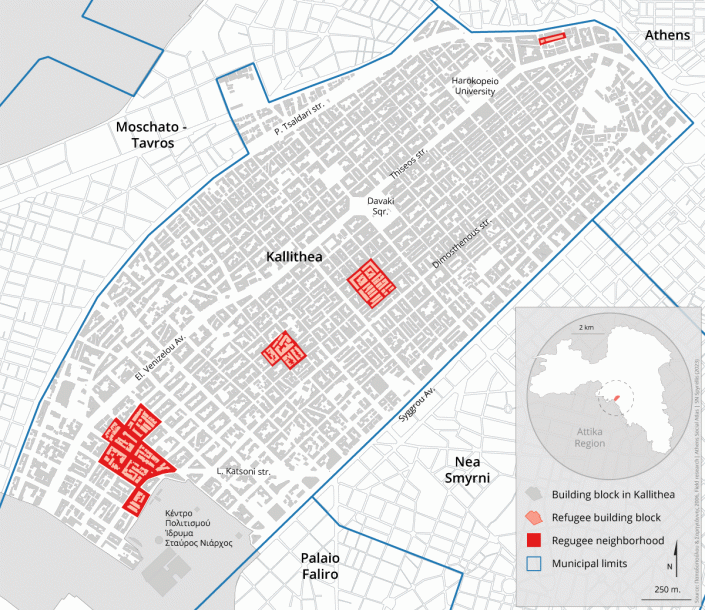Kallithea: The development of an exceptional settlement close to Athens
Myofa Nikolina
History, Quartiers
2023 | Sep
The first settlers in Kallithea and their development until the beginning of the 20th century
Kallithea had been established since 1884 [1]. The architectural plan for the Athens’ new southern suburb namely characterized by a mostly flat relief was approved in 1885 (Figure 1) with its given-name “Kallithea”. Indeed, only a few hills interspersed among the low geographical relief.
Photo 1: Approval of the plan for the creation of the Athenian suburb “Kallithea”
Kallithea means literally «which offers a splendid or beautiful view» is derived from the Greek words “kalos” (splendid or beautiful) and “view”. Specifically, the name of the area defines the magnificent view of Kallithea towards the Saronic Gulf. The beautiful view, the short distance from Athens, and its healthy climate are the three main factors that attracted the Building Company S.A. that created the settlement. The company chose the specific area in order to construct an exceptional, for the Greek case, suburb that would be equivalent to the working-class districts of France (Λερίου & Μουρουγκλού, 2006). The president of the Building Company, who gave the name Kallithea to the area, was Efthimios Kechagias (Κασιάνης, 1996)
The aim of the Building Company S.A. was to create a working-class neighbourhood as a solution to the increasing need for good quality and affordable housing (Λερίου & Μουρουγκλού, 2006). The housing conditions for the working class at the beginning of the 20th century were characterised as “miserable” (Λεοντίδου, 2001), so the needs of that population group were urgent, considering that the two Balkan Wars and World War I restricted to a great extent the country’s financial resources (Leontidou, 1990).
To begin with, the Building Company S.A. bought 910 acres in the area (between the modern districts of Harokopou and Agia Eleousa), where the first core of the settlement was planned. Prospective landlords / homeowners (mainly workers) would be facilitated in buying a property, receiving a loan from the company. After making a deposit, they would be able to pay off this loan through monthly small instalment payments at low interest rates. The company’s goal was to design the area using the Hippodamian (orthogonal grid) Plan (Λερίου & Μουρουγκλού, 2006).
Photo 2: The first Town Planning of Kallithea which was ultimately not implemented
Source: Κασιάνης, 1996:17
Finally, this ambitious plan was never implemented as its designers inspired it (Photo 2). The main reasons were the lack of sufficient funds, the death of the plan’s conceptor (Κασιάνης, 1996) and the financial inadequacy of the Company (Λερίου & Μουρουγκλού, 2006). Nonetheless, during its future development and expansion, Kallithea conserved an hippodamian city plan which makes this suburb an exceptional case in Athens.
In order to deal with the financial problems that arose, the company sold the plots at low prices. Finally, the goal of the Building Company S.A. was never completed. Instead, Kallithea became a summer settlement for prosperous Athenian residents (Λερίου & Μουρουγκλού 2006, 61) (Photo 3). Ernst Ziller was the architect who undertook the construction of the first houses. Residents were attracted to Kallithea due to the privileged location of the area and the availability of land. Gradually, the area began to change from a summer settlement location to a place of permanent residency, mainly because the quality of life was better than in Athens (ibid.).
Photo 3: The first two houses built in Kallithea belonged to Giorgos Filaretos and Laskaris Laskaridis (right and left respectively)
Photo: Καρδαμίτση-Αδάμη, 2003: 11
At the beginning of the 20th century, the social physiognomy of the area began to change. The area turned from a place of residence for high socio-economic strata into one for broader middle-and lower-working classes [2]. The new residents of Kallithea were lawyers, teachers, pharmacists, painters, soldiers, senior civil servants, architects, landowners, brokers, building contractors, grocers, bakers, and coal merchants (Λερίου & Μουρουγκλού 2006, 65). Also, among the new residents were internal migrant farmers who settled in Kallithea from various regions of Greece. The newly arrived populations, who were farmers, worked either in the fields and gardens around Kallithea or as stockmen in the cowsheds of the area. Some others worked in municipal slaughterhouses and factories that gradually began to settle in the area (although at the beginning of the 20th century, their number was limited) (ibid.).
This change in terms of the characteristics of the new residents settling in the area was reflected in the quality and size of the houses. The newly-built houses were less luxurious than the previous ones (Λερίου & Μουρουγκλού, 2006). The Building Enterprise Company, which was established in 1909, undertook to continue the work of building houses in the area. Thus, the company constructed 50 two-story detached houses in the northern part of Kallithea (the Harokopou area) in a place different from the original core, where the first residents settled. Thus, a form of horizontal social segregation was created. The poorest socio-professional strata were living on the ground floor houses, the middle ones in the Harokopou area, in houses of the best quality and architecture, while the upper socio-professional strata had already, from the previous period, been settled in the stately homes that had been constructed for this purpose, in the area between Harokopou and Agia Eleousa (Λερίου & Μουρουγκλού 2006: 65, 68) (see Map 1 the first core of houses between Harokopou and Agia Eleousa areas, while some facilities scattered in the Tzitzifies area are observed).
Settlement of Asia Minor Refugees in Kallithea
The settlement of refugees from Asia Minor [3], affected the development of Kallithea, as it happened with Athens, Piraeus, and other cities in Greece (Λεοντίδου 2001, see more Myofa 2023). The needs for housing of the newly arrived population in the country −approximately 1.5 million refugees from Asia Minor, Pontus, and Thrace− were very intense. Therefore, for the housing rehabilitation of refugees, whole areas were used as settlements (Μυωφά & Σταυριανάκης 2019). So, the development of the area as a suburb of Athens was paused due to the need for housing for the refugees.
In 1925, Kallithea which was part of the Athens Municipality was separated from it and obtained the status of community. In 1933, due to the increase in its population, Kallithea was transformed into an autonomous Municipality (Δήμος Καλλιθέας 2021). Tzitzifies, the area located in the southernmost part of Kallithea, was until 1926 part of the community of Neo Faliro. Since then, Tzitzifies has become part of Kallithea (ΦΕΚ 234Α).
Before the influx of refugees, according to the population census of 1920, Kallithea had 4,185 residents, and Tzitzifies had only 446 residents (Υπουργείον Εθνικής Οικονομίας – Γενική Στατιστική Υπηρεσία της Ελλάδος, 1921: 49). According to the 1923 refugee census, 3,336 refugees settled in Kallithea, while 339 settled in Tzitzifies (Υπουργείον Εθνικής Οικονομίας – Γενική Στατιστική Υπηρεσία της Ελλάδος 1933, 4). In 1928, Kallithea had 29,656 residents. Therefore, within 8 years, the population of Kallithea increased almost seven times. Also, based on the 1928 census, 14,036 refugees settled in the area following the Asia Minor Catastrophe (Υπουργείον Εθνικής Οικονομίας – Γενική Στατιστική Υπηρεσία της Ελλάδος 1933, 34). In the metropolitan area of Athens, the number of refugees who settled in Kallithea was the third largest, after the municipalities of Athens and Piraeus [4] (Μυωφά & Σταυριανάκης 2019, 150).
Photo 4: Photo of the Skopetiriou refugee settlement at the intersection of Platonos and Filaretou streets
Source: Γεωργιτσογιάννη, 2003: 13 (photographic archive of Nikos F. Politis)
The settlement of refugees in Kallithea took place in shacks built by various state agencies [5], in shacks that the refugees built by themselves, or in buildings on Syngrou Avenue near the borders with Nea Smyrni, but also in scattered points within the area (Photo 4). These points were in the southern part of the area, in Tzitzifies, in the northern part in Harokopou district, and also on the banks of Ilisos (Παπαδοπούλου & Σαρηγιάννης 2006, 90). For example, for the housing of refugees, a settlement (with shacks) was created in an area that belonged to the state next to the Harokopio School of Home Economics (Photo 5) (today the Harokopio University of Athens is located there). The refugees self-housed in “12 shacks located there, vertically to the bank. Later on, arbitrary installations were added to that space.” (ibid, 193)
Photo 5: Map of the Greek Statistical Bureau (EΣΥΕ) showing the outposts of Harokopou settlement
Source: Παπαδοπούλου & Σαρηγιάννης, 2006:194
All the shacks in the area were demolished in the post-war period (for more Myofa, 2023). Today, in the place of the shacks, there are mainly apartment buildings that were constructed later (Παπαδοπούλου & Σαρηγιάννης, 2006:90) through the land-for-flat system of antiparochi [6]. On the contrary, the apartment buildings that were constructed by the Ministry of Welfare in the late 1930s remain today (Map 2).
Map 1: Kallithea as depicted on a map in 1908 by the students of the Non-Commissioned Officers School headed by the professor of Topography Infantry Captain An. Katsimidis
Source: Army Geographical Service (ΓΕΣ)
For example, the estate of 15 two-story apartment buildings (ibid., 185) in Tzitzifies, as well as the estate of six two-story apartment buildings north of Tzitzifies (ibid., 95). In addition, in the limits of Harokopou district was built by the EAP (as mentioned by Παπαδοπούλου & Σαρηγιάννης, 2006) a three-story apartment building—of the same morphology as those on the southern side of the area—with 42 apartments (ibid., 196), still standing today [8]. (Photo 6a, 6b and 6c).
Photos 6a, 6b and 6c: The three-story refugee apartment building with 42 apartments replacing the Harokopou settlement. On the side of the building marks from the bullets shot during the December 44′ conflicts, can be seen
Source: Προσωπικό αρχείο
According to the General Urban Plan of 2006 (ΦΕΚ 192Δ) –as well as its former ones (of 1989 and 1993)– the aim was to indicate the refugee areas as buildings of historical and architectural value and the implementation of their regeneration. However, no programme has been implemented. Therefore, the estates that are finally saved are in bad condition (Παπαδοπούλου & Σαρηγιάννης 2006, 95:185) due to the economic inadequacy of the owners in carrying out the necessary maintenance work of the private and collective spaces of these estates. Generally, the issue of providing assistance to the owners of these apartments is a constant demand for homeowners in areas with housing estates (Myofa, 2023).
Map 2: The refugee apartment buildings that have survived to this day in Kallithea
Data source: Παπαδοπούλου και Σαρηγιάννης 2006, field research
Post-war period in Kallithea
In the post-war period, mainly from the 1960s to the 1980s (see graph 1), the population of Kallithea grew rapidly (doubled) due to internal migration. Natives from various regions of Greece have flowed into Kallithea since the 1950s to find work in the industrial units of the area. The social physiognomy of the area maintained the characteristics of the previous period (i.e., it continued to be the place of residence of intellectuals and artists) until the beginning of the 1950s. However, its development into a commercial and industrial centre with the creation of many shops and small industries was the main reason for the attraction of workers in these fields to the area (Γεωργιτσογιάννη κ.ά. 2005: 346).
Graph 1: Population evolution of Kallithea in the period 1928-1981 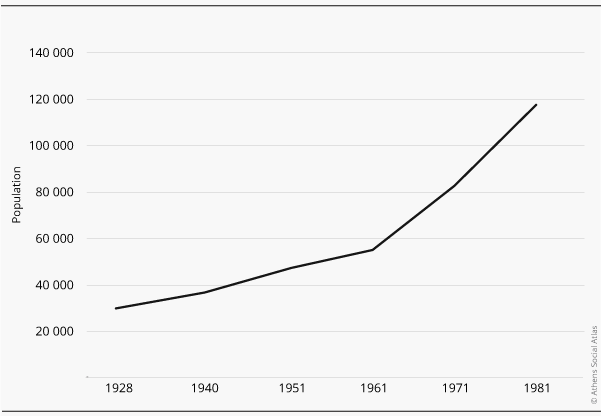
Data source: The corresponding population censuses
Photo 7: Advertisements of the well-known crafts IZOLA and EL.VI.ELA that were based in Kallithea
Source: Γεωργιτσογιάννη, 2003:15
Some of these small industries were established in Kallithea before World War II, while others after the war. Some of the most famous industries were IZOLA, which manufactures household electrical appliances based in Tzitzifies, the Hellenic Tire Industry (EL.VI.ELA) [8] (Figure 7), the textile industry Piraiki-Patraiki, the Saridis furniture industry (Figure 8), etc. (Λερίου & Μουρουγκλού, 2006: 213-215). Newly arrived populations, with a low-cost labour force, could work in these factories.
Photo 8: Photo of the Psalti-Woodworking industry (later known as the Saridis furniture factory) on Syngrou Avenue near Panteion University
Source: Γεωργιτσογιάννη, 2003:13 (photographic archive of Nikos F. Politis)
However, in the following years, and especially after 1960, these industries that employed a significant number of residents of Kallithea were closed, and as a result, the composition of the population changed and the area transformed into a commercial centre, which covered not only the needs of its residents but also those of the wider area. Since the 1970s, most of the residents of Kallithea, are “employees of the wider public sector, merchants, self-employed, and low-income earners” (Λερίου & Μουρουγκλού, 2006: 247).
This rapid increase in the population of Kallithea during the post-war period created new needs for more housing. The aim was to house the growing population of the area. In order to support these needs, many apartment buildings were constructed using the method of antiparochi–which was the dominant method during the period 1950-1980– either on empty plots or after the demolition of several of the old one or two-story buildings in the area. The intense reconstruction gradually turned Kallithea into a densely built-up area with tall buildings and a high population density. Indicatively, while Kallithea was the sixth most densely populated area of Athens in 1951, it became the most densely populated area of Athens in 1991 (Κοτζαμάνης, 1997) and Greece in 2011 (ΕΛΣΤΑΤ,2012:2).
In addition, an essential change in the post-war period that changed the trajectory of the area was the relocation of many refugee families in the 1970s to the neighbouring areas of Tavros, Nea Smyrni, and Perissos (Λερίου & Μουρουγκλού, 2006:247). The number of refugees in Kallithea gradually began to decrease. Probably, due to the increase of lending opportunities, some of the more affluent refugees seek housing solutions outside Kallithea.
Conclusion
Kallithea, from an exceptional, for the Greek case, suburb, which would be equivalent to the working-class districts of France, transformed into a place of country residence for the upper socio-occupational strata of Athens, and eventually, in the beginning of the 20th century, transformed into a place of residence for the wider middle and for the lower-working classes. Later, the influx of refugees in 1922 and their need for housing rehabilitation intensively changed the physiognomy of the area. Previously vacant, empty neighbourhoods were populated by refugees. In addition, during the post-war period, especially since the 1960s, the internal migration of the rural population to the cities strongly affected the development of Kallithea. The intense reconstruction of the area with the antiparochi system in the post-war period, resulted in the creation of the intense problems that Kallithea is facing today, such as dense construction and a lack of free spaces.
Acknowledgements
I would like to especially thank Mr. Georgios Voutsinos, resident of Kallithea and Music teacher for the material he shared with me as well as his kind offer to give me copies of Kallithea’s old maps that he has in his collection. I also thank Eveline Durie, Laboratory Teaching Staff Member at the Department of Geography of the Harokopio University of Athens, for the comments she made in the Greek and English versions of this paper. I also thank the Hellenic Military Geographical Service for giving me permission to publish the excellent Kallithea-Brahami topographic map.
[1] The area was used only for the cultivation of barley by the residents of Plaka (Κασιάνης 1996: 17).
[2] A large number of residents worked in the Electric Railway Company which had its premises in the area since 1886 (Λερίου & Μουρουγκλού, 2006:61).
[3] Due to the defeat of the Greeks in the Asia Minor Campaign in 1922 and the subsequent signing of the Lausanne Treaty in 1923.
[4] Athens, Piraeus and Kallithea are the areas that received the highest percentage of refugees (93%) (Μυωφά & Σταυριανάκης, 2019:150).
[5] The state agencies were the Refugee Care Fund (TPP in Greek), the Refugee Settlement Commission (EAP in Greek) and the Central State with the Ministry of Welfare (for more Myofa, 2023)
[6] The antiparochi system was based on the agreement between the landowner and the builder–contractor. The aim of this agreement was the construction of a polykatoikia at the lowest possible cost and the distribution of the apartments to each actor according to their participation in the investment (Αντωνοπούλου, 1991)
[7] However, it is more likely that this building was either built entirely by the Ministry of Welfare or that its construction was completed by the Ministry, since the EAP ceased to operate in 1930. The first refugee apartment buildings were constructed in 1934 by the Ministry of Welfare (Λεοντίδου, 2001: 233)
[8] This industry produced the well-known sport shoes of the time
Entry citation
Myofa, N. (2023) Kallithea: The development of an exceptional settlement close to Athens, in Maloutas T., Spyrellis S. (eds) Athens Social Atlas. Digital compendium of texts and visual material. URL: https://www.athenssocialatlas.gr/en/article/kallithea/ , DOI: 10.17902/20971.114
Atlas citation
Maloutas T., Spyrellis S. (eds) (2015) Athens Social Atlas. Digital compendium of texts and visual material. URL: https://www.athenssocialatlas.gr/en/ , DOI: 10.17902/20971.9
References
- Αντωνοπούλου Σ (1991) Ο μεταπολεμικός μετασχηματισμός της ελληνικής οικονομίας και το οικιστικό φαινόμενο 1950-1980. Αθήνα: Παπαζήσης.
- Γεωργιτσογιάννη Ε (2003) Η κοινωνική σύνθεση. Στο: Λιόντης Κ. (επιμ) Η Καθημερινή Επτά ημέρες. Αφιέρωμα Παλιά Καλλιθέα, 13 Απριλίου, σελ. 12-16.
- Γεωργιτσογιάννη Ε, Κιτσαρά Α & Μαυρογεώργη Ν (2005) Η Καλλιθέα και ο τύπος της. Στο Δρούλια Λ (επιμ) Ο Ελληνικός τύπος 1784 ως σήμερα: Ιστορικές και θεωρητικές προσεγγίσεις. Αθήνα: Ινστιτούτο Νεοελληνικών Ερευνών, σελ. 345-351.
- Δήμος Καλλιθέας (2021) Επιχειρησιακό πρόγραμμα Δήμου Καλλιθέας 2020 – 2023. Διαθέσιμο στο: https://kallithea.gr/wp-content/uploads/2022/05/2020-2023-ΣΤΡΑΤΗΓΙΚΟΣ-ΣΧΕΔΙΑΣΜΟΣ-Δ.-ΚΑΛΛΙΘΕΑΣ-Α-ΦΑΣΗ.pdf
- ΕΛΣΤΑΤ (2012) Δελτίο Τύπου-Ανακοίνωση των αποτελεσμάτων της Απογραφής Πληθυσμού-Κατοικιών 2011 για το Μόνιμο Πληθυσμό της Χώρας.
- Θεοχαροπούλου Ι (2022) Χτίστες, νοικοκυρές και η οικοδόμηση της σύγχρονης Αθήνας. Onassis Foundation.
- Καρδαμίτση-Αδάμη Μ (2003) Πολεοδομική ταυτότητα. Στο: Λιόντης Κ. (επιμ) Η Καθημερινή Επτά ημέρες. Αφιέρωμα Παλιά Καλλιθέα, 13 Απριλίου, σελ. 8-11.
- Κασιάνης Ε Θ (1996) Η Καλλιθέα. Σελίδες από την ιστορίαν της 1884-1963. Καλλιθέα.
- Κοτζαμάνης Β (1997) Αθήνα 1848-1991: Η δημογραφική ανάδυση μιας Μητρόπολης. Επιθεώρηση Κοινωνικών Ερευνών 92-93: 3-30. https://doi.org/10.12681/grsr.703
- Λεοντίδου Λ (2001) Πόλεις της σιωπής. Εργατικός εποικισμός της Αθήνας και του Πειραιά, 1909-1940, 2η έκδοση. Αθήνα: Πολιτιστικό Τεχνολογικό Ίδρυμα ΕΤΒΑ.
- Λερίου Α & Μουρουγκλού Α (2006) Καλλιθέα. Όψεις της ιστορίας του δήμου και της πόλης. Αθήνα: Αλέξανδρος, Πολιτιστικός Οργανισμός Δήμου Καλλιθέας.
- Maloutas T. (2003) The self–promoted housing solutions in post-war Athens. Discussion Paper Series 9 (6): 95-110.
- Μυωφά Ν (2021) Συγκροτήματα κοινωνικής κατοικίας στην Αθήνα. Στο Μαλούτας Θ, Σπυρέλλης Σ (επιμ) Κοινωνικός άτλαντας της Αθήνας. Ηλεκτρονική συλλογή κειμένων και εποπτικού υλικού. https://www.athenssocialatlas.gr/άρθρο/συγκροτήματα-κοινωνικής-κατοικίας σ/
- Myofa N (2023) Social housing policy in the metropolitan area of Athens during the period 1922–2012. Urban History, 50 (2): 319-338 https://doi.org/10.1017/S0963926821000791
- Μυωφά Ν & Σταυριανάκης Σ (2019) Συγκριτική μελέτη των πολιτικών εγκατάστασης των προσφύγων του 1922 και του 2016 στη μητροπολιτική περιοχή της Αθήνας. Αειχώρος. Κείμενα πολεοδομίας, χωροταξίας και ανάπτυξης. https://doi.org/10.26253/heal.uth.ojs.aei.2019.456
- Παπαδοπούλου Ε. & Σαρηγιάννης Γ. (2006) Συνοπτική έκθεση για τις προσφυγικές περιοχές του Λεκανοπεδίου Αθηνών. Αθήνα: ΕΜΠ – Σχολή Αρχιτεκτόνων Μηχανικών Τομέας Πολεοδομίας Χωροταξίας – Σπουδαστήριο Πολεοδομικών Ερευνών. Διαθέσιμο στο: https://drive.google.com/open?id=1q2F7mvPJ84bxsnPPiu0M76StwA-AORrP
- Υπουργείον Εθνικής Οικονομίας–Διεύθυνσις Στατιστικής (1921) Πληθυσμός του Βασιλείου της Ελλάδος Κατά την Απογραφή της 19 Δεκεμβρίου 1920. Εν Αθήναις – Εκ του Εθνικού Τυπογραφείου. Διαθέσιμο στο: http://dlib.statistics.gr/Book/GRESYE_02_0101_00016.pdf
- Υπουργείον Υγιεινής, Πρόνοιας και Αντιλήψεως – Τμήμα Στατιστικής (1923) Απογραφή προσφύγων ενεργηθείσα κατ’ Απρίλιον 1923. Εν Αθήναις – Εκ του Εθνικού Τυπογραφείου. Διαθέσιμο στο: http://dlib.statistics.gr/Book/GRESYE_02_0101_00017.pdf
- Υπουργείον Εθνικής Οικονομίας–Γενική Στατιστική Υπηρεσία της Ελλάδος (1933) Στατιστικά Αποτελέσματα της Απογραφής του Πληθυσμού της Ελλάδος της 15-16 Μαϊου 1928, τόμος Ι. Πραγματικός και νόμιμος πληθυσμός – Πρόσφυγες. Εν Αθήναις – Εκ του Εθνικού Τυπογραφείου. Διαθέσιμο στο: http://dlib.statistics.gr/Book/GRESYE_02_0101_00018.pdf
- ΦΕΚ 3Α/12.01.1885. Περί εγκρίσεως σχεδίου του προαστείου Αθηνών «Καλλιθέας». Διαθέσιμο στο: https://www.et.gr/api/DownloadFeksApi/?fek_pdf=18850100003
- ΦΕΚ 234Α/15.07.1926. Περί αποσπάσεως του συνοικισμού Τζιτζιφιές από της κοινότητος Νέου Φαλήρου και προσαρτήσεως αυτού εις την κοινότητα Καλλιθέας. Διαθέσιμο στο: https://www.et.gr/api/DownloadFeksApi/?fek_pdf=19260100234
- ΦΕΚ 369Δ/08.06.1989. Έγκριση Γενικού Πολεοδομικού Σχεδίου (Γ.Π.Σ.) Δήμου Καλλιθέας (Ν. Αττικής). Διαθέσιμο στο: https://www.et.gr/api/DownloadFeksApi/?fek_pdf=19890400369
- ΦΕΚ 1130Δ/16.09.1993. Έγκριση Γενικού Πολεοδομικού Σχεδίου (Γ.Π.Σ.) Δήμου Καλλιθέας (Ν. Αττικής). Διαθέσιμο στο: https://www.et.gr/api/DownloadFeksApi/?fek_pdf=19930401130
- ΦΕΚ 192Δ/13.03.2006. Τροποποίηση του Γενικού Πολεοδομικού Σχεδίου (Γ.Π.Σ.) Δήμου Καλλιθέας (Ν. Αττικής) https://www.et.gr/api/DownloadFeksApi/?fek_pdf=20060400192

